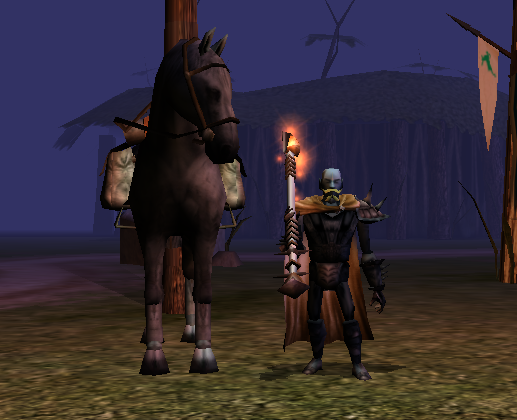Horse: Difference between revisions
(Created page with "{{Animal_Companion_Research |Name_of_Creature= Horse |Companion_Submission_Status=researching |CTS_Code= 511 |Type_of_Creature= Animal |Subtype_of_Creature= Equine |Author= ...") |
No edit summary |
||
| (5 intermediate revisions by 2 users not shown) | |||
| Line 1: | Line 1: | ||
{{Animal_Companion_Research | {{Animal_Companion_Research | ||
|Name_of_Creature= Horse | |Name_of_Creature= Horse | ||
|Companion_Submission_Status= | |Companion_Submission_Status=accepted | ||
|CTS_Code= 511 | |CTS_Code= 511 | ||
|Type_of_Creature= Animal | |Type_of_Creature= Animal | ||
| Line 11: | Line 11: | ||
|Least_Compatible_Fylgia= Giant Spider | |Least_Compatible_Fylgia= Giant Spider | ||
|Least_Compatible_Notes= Giant spiders are far removed from horses in terms of type of animal. | |Least_Compatible_Notes= Giant spiders are far removed from horses in terms of type of animal. | ||
|Introduction= | |Introduction= Horses are large, hooved mammals. It is thought that they were domesticated by the nomadic [[Romini]] when they reached the plains of what would eventually become the [[Kurathene]] Empire. Through selective breeding over the centuries there are now several breeds of horse, which can be roughly split into three categories: 1) light or riding horses, used for carrying riders quickly or for long distances, 2) medium or pack horses, used to carry large loads on their backs, and 3) heavy or draft horses, used to pull vehicles. | ||
|Feeding_Habits= | |Feeding_Habits= Horses are herbivores, and in the wild consume grasses found on temperate plains. Domesticated horses are often allowed to graze on such grasses, but are also fed hay, oats, corn, and vegetables, especially in the winter when grass may be dead or snow-covered. | ||
|Disposition_Social_Habits= | |Disposition_Social_Habits= Wild horses live together in herds. These herds consist of smaller bands which are basically a harem, with one dominant mare leading several other females and their offspring, accompanied by a single male who acts as their protector and sire. There is a pecking order among the bands, with males establishing dominance over others to determine who drinks and eats first, among other things. Domesticated horses, if grouped together, will also form a herd-like hierarchy, with the pecking order including the humans they serve. | ||
|Habitat= | |Habitat= In the wild, horses live mainly in temperate grassy plains. In civilized areas, horses can often be found in the employ of sentient races, specifically driving caravans or stabled in military areas. | ||
|Other_Notes= | |Other_Notes= Wild horses are prey animals that are often hunted by predators native to grasslands, such as [[Lion|lions]]. They are also a favorite food of griffons. Despite their strong instinct to flee from predators, horses can be trained to fight, and many races, including [[human]]s, have used them as steeds in battle. Warhorses can be trained to attack with their front legs or kick with their rear ones; such attacks can easily knock down many foes. Horses are half of the inspiration for [[Centaur|centaurs]], the race created by the lesser god [[Skern]]. Horses are similar to [[donkey]]s, and the offspring of a male donkey and a female horse is a [[Pack_Mule|mule]]. | ||
}} | }} | ||
Latest revision as of 13:14, 4 September 2018
| Animal Companion Training | Fauna Lore | Submit Research on a New Companion |

Research
Creature Name: Horse
Observations by: Deider of Pelar
Creature Type: Animal ((511))
Creature Subtype: Equine
CTS trainable: Yes (compatible with CTS).
Introduction
Horses are large, hooved mammals. It is thought that they were domesticated by the nomadic Romini when they reached the plains of what would eventually become the Kurathene Empire. Through selective breeding over the centuries there are now several breeds of horse, which can be roughly split into three categories: 1) light or riding horses, used for carrying riders quickly or for long distances, 2) medium or pack horses, used to carry large loads on their backs, and 3) heavy or draft horses, used to pull vehicles.
Feeding Habits
Horses are herbivores, and in the wild consume grasses found on temperate plains. Domesticated horses are often allowed to graze on such grasses, but are also fed hay, oats, corn, and vegetables, especially in the winter when grass may be dead or snow-covered.
Disposition and Social Habits
Wild horses live together in herds. These herds consist of smaller bands which are basically a harem, with one dominant mare leading several other females and their offspring, accompanied by a single male who acts as their protector and sire. There is a pecking order among the bands, with males establishing dominance over others to determine who drinks and eats first, among other things. Domesticated horses, if grouped together, will also form a herd-like hierarchy, with the pecking order including the humans they serve.
Habitat
In the wild, horses live mainly in temperate grassy plains. In civilized areas, horses can often be found in the employ of sentient races, specifically driving caravans or stabled in military areas.
Fylgia
Most compatible: Dire Boar
- Like dire boars, horses are hooved animals and are extremely strong.
Other notes
Wild horses are prey animals that are often hunted by predators native to grasslands, such as lions. They are also a favorite food of griffons. Despite their strong instinct to flee from predators, horses can be trained to fight, and many races, including humans, have used them as steeds in battle. Warhorses can be trained to attack with their front legs or kick with their rear ones; such attacks can easily knock down many foes. Horses are half of the inspiration for centaurs, the race created by the lesser god Skern. Horses are similar to donkeys, and the offspring of a male donkey and a female horse is a mule.